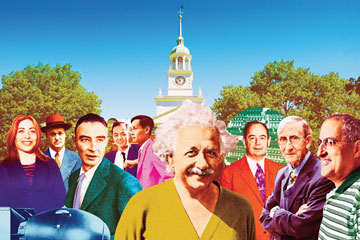
A new visitor to the institute for Advanced Study in Princeton, N.J., might at first think it was abandoned. A cluster of buildings that sits on the edge of a weedy field behind a wooden sign whose paint is chipping, the institute is not a university or a typical research center but a place where a couple hundred geniuses--Albert Einstein was an early faculty member--can go, for varying lengths of time, to indulge their curiosity. About a 20-minute walk from Princeton University (the two are not affiliated), it feels nothing like it. There are no undergraduates walking on the paths, no music blaring, no flyers advertising parties. Even the monastic apartment buildings where the scholars live seem not to emit any noise. It is as if every person on campus were holding in a sneeze for fear it might stop a transformative discovery.
The institute offers researchers a place to work unhindered by the pesky objectives required by traditional research centers or obligations to pimply students at universities. If research were measured on a spectrum from the practical (like making a laptop slimmer) to the theoretical (like studying the way matter moves in space), the institute is as "close to the frontier as possible," says its new director, Dutch mathematical physicist Robbert Dijkgraaf. The atmosphere, free from practical constraints and flush with great minds--33 Nobel laureates have stopped through along with more than two-thirds of the winners of the Fields Medal, math's top honor since 1936--was designed to create the ideal conditions for discovery. And in many cases over the years, it has. In its prolific early history, physicists Chen Ning Yang and Tsung-Dao Lee discovered that nature is not symmetrical, mathematician John von Neumann created the prototype on which future computers were built, and historian and diplomat George Kennan developed the intellectual foundations of realist foreign policy.
But while the institute's future is mostly assured by a healthy $650 million endowment, elsewhere in the U.S. the kind of work it fosters is staring down the barrel of a rough future as the government spends less than in past decades on research as a share of GDP. Many countries in Europe and Asia, meanwhile, are heading the other direction. The Chinese government--coming from far behind--has been pouring money into research and development at such a clip that according to one estimate from Battelle, a nonprofit technology-development group, its spending will surpass America's in just 10 years. Chinese universities, which hardly awarded doctorates years ago, are now, albeit barely, competing with the U.S. for students. The U.S. is already falling in some measures of innovation: in the decade from 2000 to 2010, the U.S. share of science and engineering academic citations dropped precipitously, putting it in close competition with the E.U.
